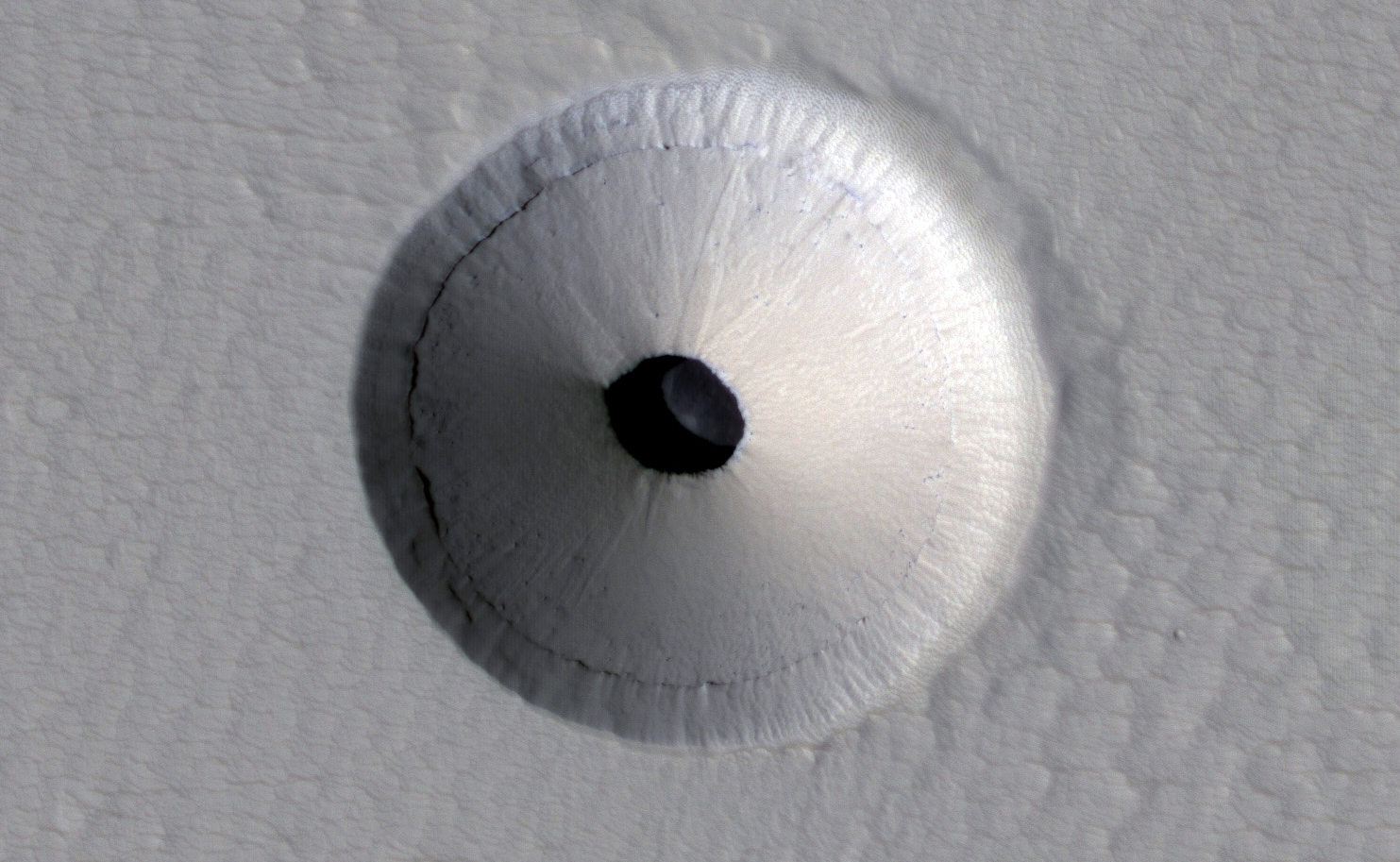by Matthew Cobb
We’ve featured the amazing images from the HiRISE Mars orbiter before. Here’s a stunning crater that was captured in 2011, on the slopes of Pavonis Mons, one of the massive extinct volcanoes on the Red Planet.:
Shane Byrne at the HiRise site run jointly by the University of Arizona says that the hole at the bottom is 35 m across, and about 20 m below bottom of the crater (they worked this out by the movement of the shadows) (All photos NASA/JPL/University of Arizona). The cavern that we are looking into is of unknown size. Shane writes:
Caves often form in volcanic regions like this when lava flows solidify on top, but keep flowing underneath their solid crust. These, now underground, rivers of lava can then drain away leaving the tube they flowed through empty. (…) The origin of the larger hole that this pit is within is still obscure. You can see areas where material on the walls has slid into the pit. How much of the missing material has disappeared via the pit into the underground cavern?
Here’s a larger version (click to see the stunning full size image). Imagine you are an explorer on Mars – could you walk down the slope of the crater, and then use a rope to get down into the bottom of the cavern, and look back up? Or is the surface of the crater thin and would it break under your weight?

Here’s the original image that caught the attention of the HiRISE team:

Of course, it might not be a crater and a cavern at all. Here are two other options:





It looks very recent too.
I’d say “fresh” rather than “new” ; the structure is routinely being renewed by slippage into the hole at the bottom.
It could have been there for a very long time, slowly draining. It depends on how big the chamber at the bottom is – and they can be pretty big.
Giant Martian ant-lions! W00t!
/@
Surely it’s obvious from the geometrical precision of this feature that it is the work of a hyper-advanced intelligent society. Beneath the crater is undoubtedly a metropolis of a sophistication that we can only dream of. The volcanic lava void story is patently an invention of the FBI/CIA/Industrial-Military Complex to hide the truth from us.;-)
Hyper-advanced intelligent social giant Martian ant-lions!!!
/@
🙂 Warning! Warning! ALL Martian ants, Warning!
That’s what I decided it was once I got the christ out of my eye and the dome was revealed to be a proper funnel.
I’m glad you spelled it w00t! WOOT is heretical.
No one would have believed that
in the last years of the 19th century
that human affairs where being watched
from the timeless worlds of space….
Ulla!
*were (lazy copy & paste from lyrics site fail)
In the presented orientation – default assumption being ‘lit from above’ – I had great difficulty in seeing a crater rather than a conical mound. Now I can’t get it to switch back.
I often have the same problem. Sometimes by concentrating on how the light must be shining, I can force it to flip.
If you can save the image and then view it in a program that allows you to rotate it in steps of 90°, it can work.
Try softening your gaze, and depend more on your peripheral vision. Might work for you.
I can get it to look indented if I try really hard, but it keeps flipping back to protrusive! Aarrrgh!
It is stuff like this that attracted me to science years ago (early NASA in the late 50s) and that still keeps me interested and engaged today.
Thank you Jerry. I will share this with my grandkids.
It’s definitely that last one; the Carkoon option. I’m pretty sure I can make out the teeth.
Sorry if this is a dumb question…but are the crater and the surroundings covered by ice?
Dry ice that is on top of water ice.
Are you sure? Pavonis Mons is almost on the Martian equator & unlike Earth there isn’t much atmospheric pressure so surface ice should sublime away unless permanently in darkness. The HiRise camera images at three wavelengths & then decisions are made on Earth how to combine this information. I suspect it’s an artifact of the colour mixing, but I’m happy to be shown wrong ~ not my expertise
Nope ; pretty dry dust.
There is both dry ice and water ice on Mars, but this is the behaviour of a loose granular material in a layer above something solid in which a hole has been punched.
I’m going to state the obvious and say, wow that camera is high resolution! Yes, I know it’s part of the name, but it’s impressive to see the proof of its ability to resolve images like this!
Here’s the original image that caught the attention of the HiRISE team:
That looks suspiciously like an acoustic ceiling tile.
example
When this image was first released, we discussed it considerably at my caving club – this being very definitely in our territory. The approach of choice to get in (and get out again!) would be to drive multiple stakes and “deadman” anchors (instruction leaflet at http://dmmclimbing.com/instructions/deadman-bulldog-terrier.pdf ; on training courses we’d have the trainees set one of these, then tie into the rope and “do a Whymper” running down a snow slope. Generally the anchor would hold ; occasionally we’d trigger an avalanche ; and sometimes we’d have to re-set the anchor because it hadn’t set properly (part of the point of the training!).
Anyway ; deadmen backing up stakes, a good (20-30m) back from the edge of the collapse pit. Then on rope and over the edge into the pit and go down to examine the edge of the drop. Look for the most stable part of the edge – you may need to move around to a different anchor point.
Once you’ve selected the best bit of edge and re-positioned your top rope to suit the rock, it’s back over the edge to the lip of the drop. Set a rebelay anchor (self-driller for exploration ; Y-hang off glued-in bolt anchors for long-term use) at the lip, so that your rope doesn’t rub when you’re climbing back up it. Very cautiously over the lip to weight test the rebelays then adjust the knots for equal loading, change over to the newly anchored rope and start abbing down into the void.
Total weight of equipment and ropes under 50 kilos for two people, and nothing new and un-tried in either equipment or technique.
A racing certainty – 90% odd probability – is that it’s a “window” into a “lava tube” cave.
Reading your comment, I now recall a story about my late Manchester Zoology colleague, Derek Yalden. Derek was an expert on mammals in the Uk and in Ethiopia. At an event to mark his life, earlier this year, the story was told of how he dropped into a lava tube cavern very like this in Ethiopia, looking for mammal bones. There was a colleague on the surface, but that was it. They were miles from anywhere and this was years before mobile/cell phones. Derek got out Ok (with his collection of bones), but it was pretty hairy. He was a fit old bird, but I’m not sure even he could have coped with this on Mars… Vale, Derek! – Matthew Cobb
Well, at Manchester Uni I’d be surprised if he didn’t have access to a good number of serious troglodytes to train him in appropriate “silly rope tricks” (SRT = Single Rope Technique, if you want to be formal ; “dopes on ropes” if you’re a scaffolder).
It’s not remarkably difficult. Not even particularly strenuous. But it does require both training and practice.
In the field sciences, most people can think back to “I shouldn’t have done that” experiences. Didn’t I quite the “Rime of the Ancient Mariner” recently? A really important trick is to do the “[wake] the morrow’s morn” bit of the last couplet.
In other news – I’ll try to make it down to the May or August Gaping Ghyll meet on Ingleborough. If you want a good run around in the dark and mud – drop me a line. Be prepared to be accosted by humanoid troglodytes with tales of various phyla of troglobites. Bring a beer mug, relatively clean clothes and a sleeping bag ; your liver may be left at home for safe keeping.
No, it is a close head-on view of the tip of a white pencil which has been glued to a white-painted wall. On Mars.
small space rock punched a hole into a pre-existing subsurface chamber (origin as described in the post). Most material was thrown out. Since then down-hill wasting has caused slipping of material from the walls of the crater into the hole at the bottom. Do not go down there on a rope – it is obviously the domain of those strange winged intergalactic creatures who came to our solar system many millions of years ago. The same who colonised Antartica. Tekeli-li!!
now where are those six foot tall albino cave penguins?
They look like Mars titties to me – they look like cones. 😀
(sub)
Could it be a solutional collapse doline ?
In the larger scale picture the pockmarks around the main feature, Look remarkably like a doline field!